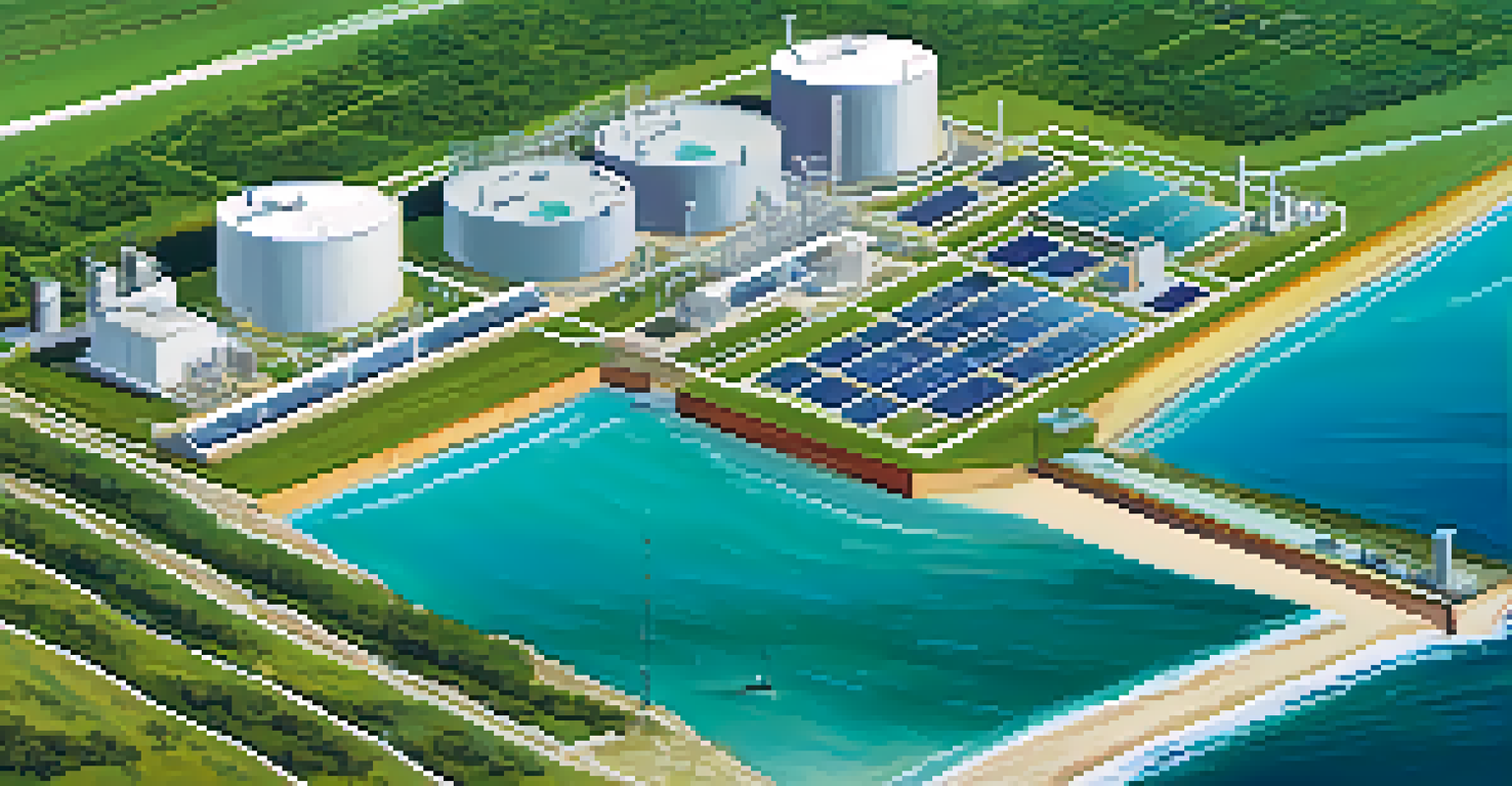Desalination: A Viable Solution for Arizona's Water Crisis?

Understanding Arizona's Water Crisis and Its Challenges
Arizona faces a significant water crisis driven by drought, population growth, and over-reliance on the Colorado River. As the state's water supply dwindles, residents and policymakers are searching for sustainable solutions. This situation is compounded by climate change, which continues to impact the availability of fresh water.
Water is the driving force of all nature.
The state's major water sources are dwindling, leading to tough decisions about water usage and conservation. Groundwater depletion is also a pressing concern, as many communities rely on aquifers that are being rapidly exhausted. Without innovative solutions, Arizona may face severe water shortages in the near future.
The urgency of the situation makes exploring alternatives, such as desalination, more critical than ever. While it may not be a complete fix, it offers a new perspective on how to manage water resources effectively. Understanding these challenges sets the stage for evaluating desalination as a viable option.
What is Desalination and How Does It Work?
Desalination is the process of removing salt and other impurities from seawater or brackish water to produce fresh water. This technology can be a game-changer for regions facing water scarcity. Typically, desalination is achieved through methods like reverse osmosis or thermal distillation.

In reverse osmosis, high pressure forces seawater through a semi-permeable membrane, filtering out salt and contaminants. This process is efficient and increasingly cost-effective, making it a popular choice for many countries. Thermal distillation, on the other hand, involves heating water to create steam, which is then condensed back into liquid, leaving salt behind.
Arizona's Water Crisis Deepens
Drought, population growth, and climate change have intensified Arizona's water scarcity, necessitating urgent solutions.
While desalination is a promising solution, it does require significant energy and infrastructure investments. Yet, with advancements in technology, these challenges are becoming more manageable. Understanding how desalination works is crucial in assessing its feasibility for Arizona.
Potential Benefits of Desalination for Arizona
Desalination presents several potential benefits for Arizona, primarily by providing a new, reliable source of fresh water. With the state's ongoing water shortages, tapping into the vast supply of seawater could help meet growing demands. This could be especially beneficial for agricultural sectors and urban areas that face water restrictions.
The future will be green, or not at all.
Moreover, desalination can enhance water security and resilience against drought. By diversifying water sources, Arizona can reduce its dependency on traditional supplies, such as the Colorado River. This shift could lead to more sustainable water management practices and increased public confidence in future water availability.
Additionally, the development of desalination plants could create jobs and stimulate local economies. From construction to operations, the investments in this technology can have far-reaching positive impacts. These benefits make desalination an enticing option for a state in dire need of water solutions.
Challenges and Criticisms of Desalination
Despite its potential, desalination is not without challenges and criticisms. One major concern is the high energy consumption associated with the process, which can contribute to greenhouse gas emissions. In a state like Arizona, where sustainability is crucial, this could undermine the environmental benefits of desalination.
Another issue is the brine waste produced during desalination, which contains concentrated salt and can harm marine ecosystems if not managed properly. The disposal of this byproduct raises environmental concerns that need careful consideration. Addressing these challenges is essential to ensure that desalination is a viable and responsible solution.
Desalination: A Promising Solution
Desalination offers a potential new source of fresh water for Arizona, helping to alleviate ongoing shortages and enhance water security.
Furthermore, the high costs of building and operating desalination plants can be a barrier for implementation. While costs have decreased over time, initial investments remain significant. Understanding these challenges is key to gauging the practicality of desalination in Arizona's water strategy.
Global Examples of Successful Desalination Projects
Many countries around the world have successfully implemented desalination projects, offering valuable lessons for Arizona. For instance, Israel has become a global leader in desalination technology, providing over 70% of its domestic water supply through these methods. Their success showcases how innovative water management can transform a country's water landscape.
In California, the Carlsbad Desalination Plant has been operational since 2015, supplying about 10% of the region's water needs. This facility demonstrates the feasibility of desalination in arid climates and highlights the importance of regulatory support and public acceptance. These examples illustrate that desalination can work effectively, even in challenging conditions.
Studying these global projects can help Arizona identify best practices and tailor solutions to fit its unique context. By learning from others, the state can better navigate the complexities of implementing desalination as part of its water strategy.
The Role of Policy and Regulation in Desalination
Effective policy and regulation will play a critical role in the successful implementation of desalination in Arizona. Policymakers must create a supportive framework that encourages investment while ensuring environmental protection. This includes establishing guidelines for brine disposal and energy use to mitigate potential negative impacts.
Public engagement is also essential to build community trust and acceptance of desalination projects. Transparent communication about the benefits and challenges can help foster a positive relationship between stakeholders and residents. Policymakers need to prioritize public education around water issues to pave the way for innovative solutions.
Challenges of Desalination Remain
Despite its benefits, desalination faces hurdles such as high energy consumption, environmental concerns, and significant initial costs.
Additionally, collaboration between governmental agencies, private sectors, and environmental organizations can drive the development of best practices. Together, they can address concerns, share resources, and maximize the potential of desalination as a water source. Creating a comprehensive policy approach is vital for the future of water management in Arizona.
Looking Ahead: The Future of Desalination in Arizona
As Arizona grapples with its water crisis, the future of desalination remains a topic of intense discussion. With ongoing advancements in technology and growing awareness of water issues, the potential for desalination to play a significant role is promising. However, it requires thoughtful planning and community involvement to become a reality.
Future desalination efforts must focus on sustainability, including renewable energy sources to power plants and responsible waste management practices. By prioritizing these elements, Arizona can embrace desalination as a forward-thinking solution that aligns with its environmental goals. This foresight can help ensure a reliable water supply for generations to come.

Ultimately, the future of desalination in Arizona will depend on a collective commitment from residents, policymakers, and industry leaders. By working together, they can transform the state's water landscape and create a sustainable path forward. The journey may be long, but the rewards of a secure water future are worth the effort.